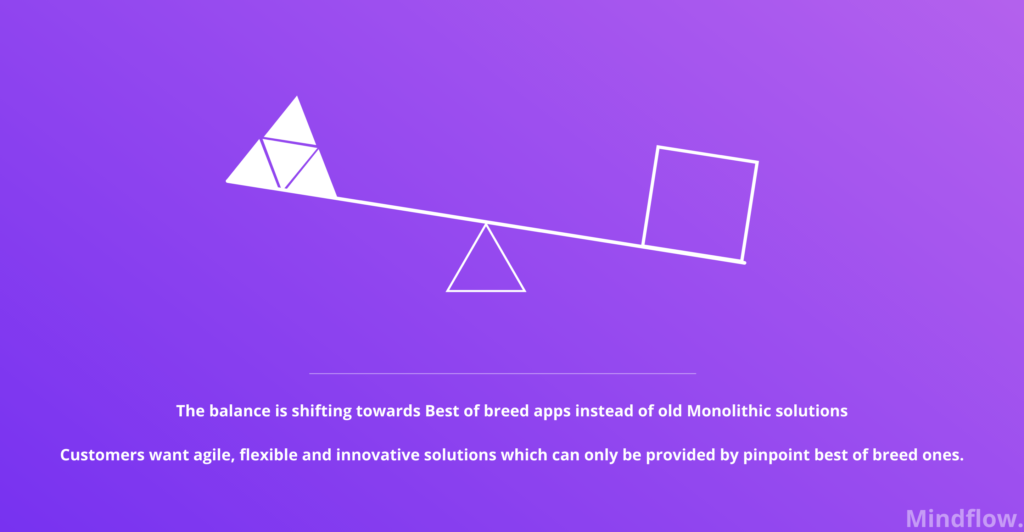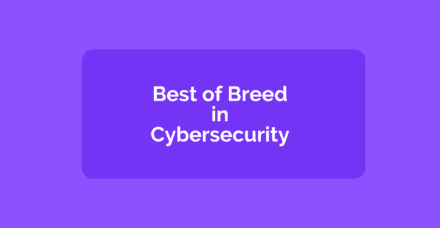Organizations are torn between two approaches when it comes to their software architecture. On the flip side, All in One (AiO) suites aim to answer every need of your organization on a unique platform. On the other side, Best of Breed (BoB) solutions, the leading pinpoint solutions among their likes to answer specific needs.
Agility, flexibility, and reactivity are now leitmotivs across all companies that want to grow fast, to surpass their counterparts.
As IT began to consumerize, following the evolution of customer apps, user experience shifted in the same way. Employees wanted to have the same experience as downloading the app they wanted on their smartphones. SaaS was developed to deliver narrow, targeted, innovative capabilities better, faster, and cheaper than their monolithic competitors to meet this need.
Today, we’re living with the reality of managing hundreds of SaaS applications, tools, and data services in modern enterprises. But do companies want to reconsider the old monolithic, integrated software platforms?
Here at Mindflow, we think that BoB is the way to go for numerous reasons, whereas AiO solutions are vowed to be overtaken. Of course, there are disadvantages, but we believe that orchestration and automation tools (SOARs in security) are perfect to balance these as we promote in our field of expertise.
With that in mind, we’ll dive into:
- Why we think All-in-One suites’ era is over;
- Alleged disadvantages of Best of Breed solutions can be overtaken with orchestration and automation;
- As such, why we believe that Best of Breed appears to be the perfect fit for your teams.
Why we think that All in One suites’ era is over
Bundles may appear attractive to an organization willing to upgrade its system in one catch or uniformize the software architecture with a suite of products from the same vendor. Take Microsoft, for example; when you subscribe to Office 365, you have access to Word, Excel, PowerPoint, Outlook, OneNote, Teams, and many other applications.
Bundles sound attractive because they can be deployed across an organization at one time. However, with bundles, employees have to rely on its products, regardless of their adequacy to the task they need to achieve.
Ultimately, it results in having to use apps that aren’t sharp enough for the purpose.
Also, if your teams are tied to such suites of products they deem inappropriate, they could start to use other tools they feel more appropriate. You would end up facing risks described as shadow IT that can seriously hamper your organization’s security or the overall coherence of your software architecture.
The bundle path can also make your company vulnerable to threats since flaws in one suite product can be present across every tool.
More, it may constrain your ability to innovate as you have to wait for vendors to release new versions and features.
To compare with the global case against concentration in the economy, let’s take a look at the consensus as of today. The growing concentration of market power allows dominant firms to exploit their customers and squeeze their employees, whose own bargaining power and legal protections are being weakened. As a result, monopolistic organizations tend to favor increasing their profits and rent than fostering further innovation.
As a result, relying on a single enterprise software provider may expose you to faces price increases. Being dependent on a single provider’s products can become a technical handicap. The software vendor could fail to keep up with the market and thriving pinpoint solutions.
As a general rule, we think that choosing brand and integration over functionality is a mistake. Even if the overall cost could be less, you can’t give up your agility or flexibility for the sake of cost reduction or to comply with corporate strategy. Creating an architecture encouraging innovation and offering the best user experience should drive every organization’s choice when choosing between AiO and BoB.
Alleged disadvantages of Best of Breed solutions can be overtaken with orchestration and automation
Uncontrolled Best of Breed approach can degenerate and hamper your organization
Instead of affording a bundled suite from a vendor that pretends to cover every need, an organization should adopt specialized solutions from different vendors to optimize performance and address specific points or to exactly meet the needs of certain tasks particular to the company or sector. This guarantees that employees use the best solution for each job function and favors agility, flexibility, and reactivity.
However, when discussing building your architecture around BoB solutions, some argue that the following disadvantages seriously hamper your organization’s performance, which leads you to choose AiO over BoB.
Such an approach would mean that large enterprises have to deal with multiple systems, databases, and vendors. Contract lifecycle management would also necessity more time and agents to manage all the vendor relationships. Overall, the cost of ownership can be significant, especially for Small and Medium Businesses (SMBs).
Integrating third-party tools could be time-consuming and challenging, especially for smaller organizations that lack the technical know-how, workforce, or infrastructure. Inadequate integration could also result in a lack of data protection and redundancy. Intensive staff training could also be implied to enhance productivity on each tool.
That’s why you should combine leading apps, automation, and orchestration only to take the best of the BoB world
At first, affording a BoB approach seems complicated, as it involves working with multiple vendors that all have their logic and pricing. But what we’re saying is, when done successfully, organizations can combine all of their BoB technologies into one fully integrated system without all the enumerated struggles listed above.
As we said in a former article about the tool sprawl, the problem isn’t about the accumulation of tools but rather about the control and the connectivity between them. Thus, we think that the solution to tackle BoB’s disadvantages would be to combine your software architecture with an automation and orchestration tool. It would enable users to federate the connections between your apps from one platform. For instance, ease the burden of connecting your favorite mail to your intern messaging apps or your dropbox.
Automating the interactions between the apps will make the life of your teams easier. Also, such an approach would ease the management because it would help them keep the different apps upgraded, centralize user management, and facilitate the tool-stack monitoring. In sum, maximizing the uses of each tool, thus increasing the initial investment and productivity.
Combining Best of Breed and SOAR solutions appear to be the perfect fit to enhance your teams’ performance
Handpicking pinpoint applications according to your actual needs is a better way to build your architecture than relying on a preformatted platform, where all the tools are designed to suit a greater audience. BoB apps are often quicker to deploy and, with intuitive design, are more accessible for end-users to adopt than bundles, which lower the barriers to operate and thus deliver value quicker.
Choosing BoB apps is also about choosing agility and reactivity from the provider. Laser-focused on a single problem, providers are more likely to stay afoot of the latest and most modern technology. This way, your teams are prime beneficiaries of innovation in their sector, in opposition to AiO users, where large companies tend to favor profits instead of staying at the edge of innovation. When committing to a bundle, we are taking the risk of being locked into a system that isn’t fully tailored to our needs or becomes outdated quickly. As such, handpicking helps your teams feel confident that they’re using the best tools possible in addition to a better overall user experience.
Also, BoB apps are designed to adapt, to be flexible, and they often are the first to offer a service to answer new or laser-focused needs. For instance, Zoom outperformed every solution part of AiO suites when COVID hit the world last year.
A BoB approach gives multiple advantages to SMBs. First, the opportunity to start small and expand their stack alongside their growing business. SMBs sometimes only need software for limited amounts of time or specific projects. Second, BoB makes it easier for them to find a suitable solution by avoiding committing to a full suite of products for the long term.
Finally, BoB apps combined with orchestration tools result in a highly flexible and integrated environment, allowing your teams to connect multiple systems for more efficient workflows.
Conclusion
Here, at Mindflow, we think that people deliver their best when they have the freedom to choose the best tools to achieve their work. Chaining them in bundles is hampering their potential. We don’t believe in solutions that pretend to answer all the specific needs a particular enterprise faces. We also don’t believe in the capacity of bundles to stay afoot with innovation.
We’re living in a fast-changing world, where agents have to adapt quickly, be flexible, and find laser-sharp solutions when they have to. That’s why we think that the future is Best of Breed.
This isn’t to say that we’re not aware of the Best of Breed disadvantages. On the exact opposite. That’s why we promote Best of Breed coupled with a SOAR in cybersecurity, our field of expertise. But also beyond, wherever adaptability and flexibility are essential for prosperity.
